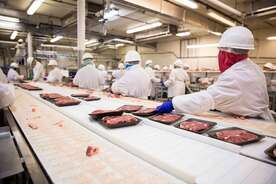 Times of high inflation and consumer demand place added pressure on suppliers to deliver to their customers. Even if you pride yourself on your restaurant’s safety practices and record, your business is only as safe as its supply chain. Protecting it, and, by extension, your own ability to ensure quality for your guests, comes down to transparency. How well do you trust each link in your supply chain? Where can you develop a better relationship with certain suppliers? You can digitally manage your supplier certifications and flag any potential gaps for further investigation – or to simply prompt a conversation that can help you build trust with suppliers.  Supply chain strains and the war in Ukraine have challenged food security around the globe and, in the process, increased the likelihood for food fraud. Seafood, which is regularly traded, is especially susceptible to it, but grains, meat and legumes have also been impacted by food fraud in recent years. Chris Elliott, food safety expert and founder of the Institute for Global Food Security at Queen’s University in Belfast, Northern Ireland, told New Food magazine recently that one of the biggest consumer risks from food fraud is the fraudulent introduction of allergens into food products, which threaten the health of a restaurant’s customers. That risk is followed by the emergence of new proteins that may come from unsustainable sources. Restaurants can best protect themselves from the rising risk of food fraud by sourcing items locally, which simplifies and clarifies the supply chain; closely monitoring the path an ingredient must take to reach their business; assessing any vulnerabilities that may exist with staff, technology, inventory procedures and suppliers; and being transparent with both staff and customers about sourcing – it will naturally help increase an operation’s awareness of fraud when it occurs.  At a time when supply chain strains make it difficult to know if or when a key ingredient will arrive, there is even more reason for restaurant operators to turn to local suppliers for menu items. Just make sure to screen these suppliers for strong food safety practices, particularly if they are small or new businesses. Every supplier should be able to demonstrate its adherence to best food safety practices, including its protocols for preventing cross-contamination. Make sure you’re comfortable with their transparency and ability to trace a food item from its source to its delivery to you. Take care with deliveries and inspect every shipment for proper color, temperature and freshness. Increasingly, consumers care about the precautions businesses are taking to protect the safety of their food en route to the businesses selling it to them. The software and engineering firm Emerson recently surveyed 1,000 U.S. consumers about food safety practices – and what they expect to see from suppliers. More than 50 percent of respondents said they would be less likely to shop at stores that aren’t using (or requiring suppliers to use) the latest technology to keep food safe. Half of respondents said they are now more concerned about the safety of their food than they were before the pandemic. Nearly 60 percent said the pandemic has made them want to support local businesses. When you promote food safety to guests, look beyond your operation. Trace the path of your menu items and try to shorten that path where possible. Share the tech products and practices that help keep their food fresh and safe between its source and their dinner table.
The coronavirus has strained the supply chain and added uncertainty to restaurant operators who need a steady supply of certain ingredients. Just make sure that supply chain pressures don’t result in cutting corners on supplier safety. Team Four can help you connect with reputable suppliers – but if you find other contenders, asking some key questions can help you discern their stability and reliability when it comes to food safety. Statefoodsafety.com advises operators to ask for information about a supplier’s food safety standards, as well as about how long the company has been in business, how it transports food, and how it would handle any problem that arises with a supplied product.
COVID-19 has made food traceability, transparency and protection all the more important – and difficult, particularly as meat facility workers have fallen ill in recent weeks and social distancing rules have limited in-person audits and inspections. So what can operators do to ensure their food supply is as safe as possible? Take this time to urge transparency from your vendors and understand what systems they are using to trace food through the supply chain. Uncertainty in the global food supply chain is also likely going to drive food businesses to think even more locally. Is there an opportunity right now for you to source more ingredients locally – or adjust your menu so you can?
A recent survey from Cornell University and the National Farmers Union found that more than 50 percent of local U.S. produce growers say they need more adequate financial resources to implement food safety practices. But if your guests are sickened after consuming contaminated produce you serve, they are likely going to hold your business responsible for causing the problem. How can you protect yourself? Food Safety Nation advises operators take three steps to help: First, inspect your suppliers to assess the quality of their safety program and training, as well as the controls in place to monitor their compliance. If possible, require a hold-harmless agreement that absolves your business of responsibility to pay claims related to the consumption of a contaminated product. Finally, seek out suppliers with certification from the Global Food Safety Initiative as an additional precaution.
As you fine-tune your menu based on seasonal changes, trending ingredients or problems with current suppliers, you are likely speaking with potential suppliers on a regular basis. At the 2018 Food Safety Consortium, Doug Marshall, Ph.D., chief scientific officer at Eurofins, recommended some key questions companies should ask when sourcing ingredients and building a strong supply chain verification program. For one, ask the supplier if they have a food safety plan and if you can review it. Second, ask if they have been part of a Global Food Safety Initiative-based audit and if they can share the results of their last audit with you. Finally, ask if the supplier has ever been part of a recall or outbreak. If so, you can research the event and find out how the company resolved it. It may not disqualify them — particularly if the event occurred just once and ushered in a retooling of safety practices that have protected the company since.
|
subscribe to our newsletterArchives
April 2024
Categories
All
|








 RSS Feed
RSS Feed